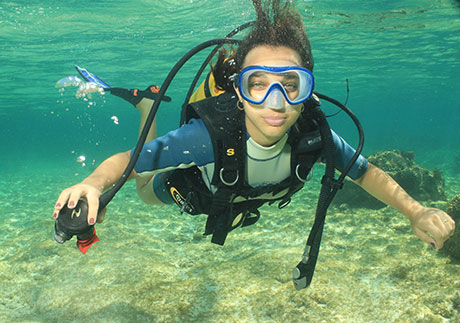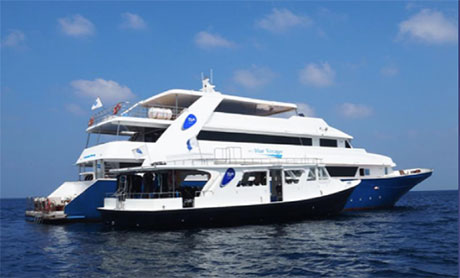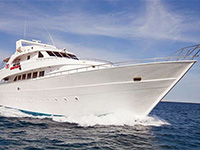SCUBA News 218
(ISSN 1476-8011)
27 August 2018
~~~~~~~~~~~~~~~~~~~~~~~~~~~~
SCUBA News (ISSN 1476-8011)
Issue 218 - August 2018
https://www.scubatravel.co.uk
~~~~~~~~~~~~~~~~~~~~~~~~~~~~~
Welcome to SCUBA News. I hope you find it useful. We love hearing from you - any questions or recommendations email news@scubatravel.co.uk.
You can download a pdf version of SCUBA News here.
Are you thinking of going to Cuba? Underwater Cuba offers travel tips, diving, tours and apartments throughout Cuba.
Learn more about Underwater Cuba
Contents:
What's new at SCUBA Travel?
Liveaboard Deals - Project Shark Expedition
Where to dive with Manta Rays?
Diving news from around the World
What's New at SCUBA Travel?
 |
Marine Life Heaven in the Sea of Cortez Manta rays and hammerheads will soon be here, in one of the most fertile seas in the world. Make sure Baja California is on your bucket list of dive trips.
|
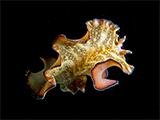 |
Masses of fish, colourful hard and soft corals plus visiting whales and whale sharks to Zanzibar and the African Spice Islands.
|
 |
September can be a tricky time to dive, as many destinations are transitioning between seasons. However, there are some magical liveaboard destinations to visit at this time of year. |
Liveaboard Deals
Dive the Maldives with marine biologist Dr Elke Bojanowski and develop your skills in collecting data and shark identification. Project Shark highlights the global issues facing sharks, with a Maldivian focus, and you'll help donate vital information to local Maldivian marine research organisations
Where to dive with Giant Manta Rays?
Awesome to see underwater, the Giant Manta Ray is an enormous fish spanning nearly 7 m (22 feet). They live in warm waters around the world, gracefully flying through the water with steady sweeps of their giant wings.
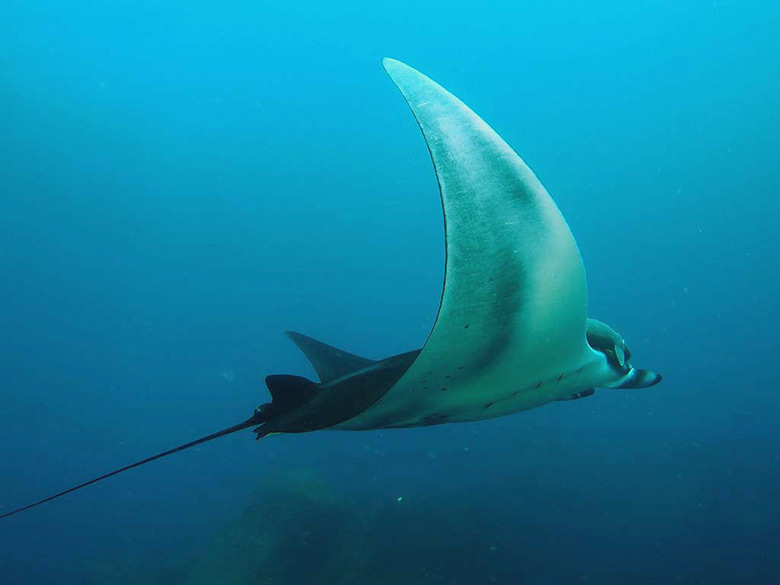
Why are Mantas so Big?
Completely harmless filter-feeders, Manta rays use their head fins to direct plankton into their mouths. As plankton occur near the surface of the seas, that's where Mantas are also found. Filtering your food out of the oceans doesn't take much energy, which is why Manta rays can be so large.
Manta rays sometimes leap out of the water, falling back with a splash. This is thought to remove parasites, or perhaps be a show of territorial rights. However, Mantas collaborate when feeding and follow the plankton, so the latter seems unlikely.
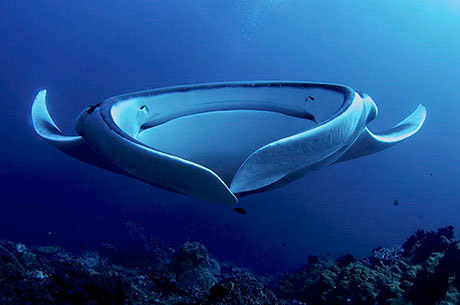
Vulnerable in Spite of their Size
Until recently people believed there was only one species of Manta Ray: Manta birostris. Now though, researchers have observed that there are actually two: the Reef Manta Ray (Manta alfredi) and the Giant Manta Ray (Manta birostris). Both of these species have been classified as vulnerable in the IUCN Red List.
Mantas migrate vast distances, crossing international boundaries, in search of food. Products from manta rays have a high value in international markets, and targeted fisheries hunt them for their valuable gill rakers used in traditional Chinese medicine. Monitoring and regulation of the exploitation and trade of both manta ray species is urgently needed, as well as protection of key habitats.
Another factor which adds to the vulnerability of the Manta ray is its low reproductive rate. In the wild, females bear on average only a single pup every two to three years. Female mantas are thought to mature at around 8 to 10 years of age and to live to around 40 years.

Photo by Tim Nicholson, taken in The Azores
Where to dive with the Giant and Reef Mantas?
Dive tourism involving Mantas is a growing industry. More money is made from live mantas than from the dead, caught mantas. However, tourism related industries can also negatively impact individual behaviour, entire populations and critical habitat. Tourism needs to be developed responsibly, with the needs of the animals respected.
An academic study of how tourism affects the manta rays gave five recommendations on diving responsibly with the rays so as not to affect their feeding behaviour.
- Observe mantas passively
- Keep 3 m between you and the manta (not always easy when the manta swims straight towards you)
- Approach from the side of the manta ray
- Inexperienced snorkellers should not dive underneath or near manta rays
- At sites with juveniles, be more cautious when approaching manta rays
Both species of Manta are found around the globe, their ranges overlapping in some places like Mozambique. It is difficult for a diver to distinguish between the two species. Both can be shades of black or white. They are also sometimes confused with the devil rays of the genus Mobula.
The Giant Manta Ray appears to be a seasonal visitor to coastal or offshore sites. While this species seems more solitary than the Reef Manta Ray, Giant Manta Rays are often seen aggregating in large numbers to feed, mate, or clean. Sightings of these giant rays are often seasonal or sporadic but in a few locations their presence is a more common occurrence. At certain times of the year you can see the Giant Manta Ray at aggregation sites such as the Similan Islands, Thailand; northeast North Island, New Zealand; Laje de Santos Marine Park, Brazil; Isla de la Plata, Ecuador; Cocos Island, Costa Rica; and Isla Holbox, Mexico. Being oceanic, you see them less frequently than the Reef Manta Ray.
A good place to go to see Reef Manta Rays is Indonesia, particularly Bali and Komodo.
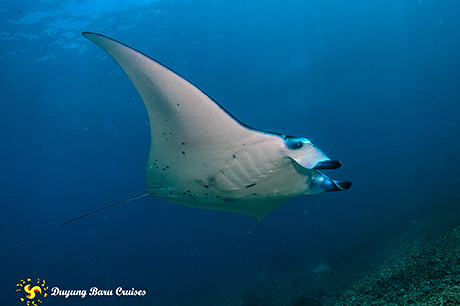
Reef Manta Ray in Komodo. Photo by Vovo Korth, Duyung Baru liveaboard
The Reef Manta Ray lives from the Sinai Peninsula in the Red Sea to Durban, South Africa in the Western Indian Ocean, and from Thailand to waters off Perth, Western Australia in the Eastern Indian Ocean. In the eastern and south Pacific, the Reef Manta Ray occurs from the islands on Ryukyu Arc, Japan in the north to the Solitary Islands, Australia in the south and is sighted as far east as French Polynesia south of the equator and Kailua Kona, Hawaii north of the equator. Reef Manta Rays do not commonly venture from coastal waters, often moving between inshore cleaning stations and feeding areas. The Reef Manta Ray can reach 5 m across, however, most mature individuals do not exceed 4 m.
Read more: https://www.scubatravel.co.uk/mantaray.html
Diving News From Around the World
Our round up of the best underwater news stories of the past month. For breaking news see our Twitter page or RSS feed
 |
Win Maldives Dive Holiday worth $5000
|
 |
Fleet of robots maps ocean fronts
|
 |
Indonesian children get free goggles to watch the reef
|
 |
Which marine mammals are most at risk from increased Arctic ship traffic?
|
 |
Using sound to detect undersea methane might help measure greenhouse gas
|
 |
Offshore wind farming: the most under rated source of energy?
|
 |
Step Inside the World's First Intertidal Art Gallery
|
 |
Guylian announce underwater seahorse photography competition
|
SCUBA News is licensed under a Creative Commons Attribution 4.0 Unported License. This means we are happy for you to reuse our material for both commercial and non-commercial use as long as you: credit the name of the author, link back to the SCUBA Travel website and say if you have made any changes. Some of the photos though, might be copyright the photographer. If in doubt please get in touch.
Photo credits: Tim Nicholson, Andrew Reay-Robinson
Previous editions of SCUBA News are archived at https://www.scubatravel.co.uk/news.html
SUBSCRIBING AND UNSUBSCRIBING
Visit [UNSUBSCRIBE] and add or remove your e-mail
address. To change whether your receive the newsletter
in text or HTML (with pictures) format visit [PREFERENCES]
ADVERTISING
Should you wish to advertise in SCUBA News, please
see the special offers at
https://www.scubatravel.co.uk/newsad.html
Other advertising opportunities are at
https://www.scubatravel.co.uk/advertising.html
CONTACTING THE EDITOR
Please send your letters or press releases to:
Jill Studholme
SCUBA News
The Cliff
DE6 2HR
UK
news@scubatravel.co.uk
PUBLISHER
SCUBA Travel, 5 Loxford Court, Hulme, Manchester, M15 6AF, UK
Subscribe To SCUBA News
Our newsletter, SCUBA News (ISSN 1476-8011), is absolutely free. It is a monthly publication, delivered by e-mail. To receive your copy fill in your details below. We will never pass your e-mail address to any third parties, or send you unsolicited e-mail.
To receive your copy fill in your details below. We will never pass your e-mail address to any third parties, or send you unsolicited e-mail.
You will receive an e-mail confirming your subscription. If you don't receive this you may have entered your e-mail address incorrectly - revisit this page and re-subscribe.
Write to SCUBA News
We love hearing from you: send us any news, dive write ups, reviews or comments

